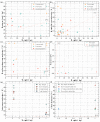A Wearable Lower Limb Exoskeleton: Reducing the Energy Cost of Human Movement
- PMID: 35744514
- PMCID: PMC9229674
- DOI: 10.3390/mi13060900
A Wearable Lower Limb Exoskeleton: Reducing the Energy Cost of Human Movement
Abstract
Human body enhancement is an interesting branch of robotics. It focuses on wearable robots in order to improve the performance of human body, reduce energy consumption and delay fatigue, as well as increase body speed. Robot-assisted equipment, such as wearable exoskeletons, are wearable robot systems that integrate human intelligence and robot power. After careful design and adaptation, the human body has energy-saving sports, but it is an arduous task for the exoskeleton to achieve considerable reduction in metabolic rate. Therefore, it is necessary to understand the biomechanics of human sports, the body, and its weaknesses. In this study, a lower limb exoskeleton was classified according to the power source, and the working principle, design idea, wearing mode, material and performance of different types of lower limb exoskeletons were compared and analyzed. The study shows that the unpowered exoskeleton robot has inherent advantages in endurance, mass, volume, and cost, which is a new development direction of robot exoskeletons. This paper not only summarizes the existing research but also points out its shortcomings through the comparative analysis of different lower limb wearable exoskeletons. Furthermore, improvement measures suitable for practical application have been provided.
Keywords: assisted movement; lower limb exoskeleton; metabolic cost; wearable device.
Conflict of interest statement
The authors declare no conflict of interest.
Figures










Similar articles
-
An Unpowered Knee Exoskeleton for Walking Assistance and Energy Capture.Micromachines (Basel). 2023 Sep 22;14(10):1812. doi: 10.3390/mi14101812. Micromachines (Basel). 2023. PMID: 37893249 Free PMC article.
-
An integrated evaluation approach of wearable lower limb exoskeletons for human performance augmentation.Sci Rep. 2023 Mar 14;13(1):4251. doi: 10.1038/s41598-023-29887-0. Sci Rep. 2023. PMID: 36918651 Free PMC article.
-
Exoskeleton robots for lower limb assistance: A review of materials, actuation, and manufacturing methods.Proc Inst Mech Eng H. 2021 Dec;235(12):1375-1385. doi: 10.1177/09544119211032010. Epub 2021 Jul 13. Proc Inst Mech Eng H. 2021. PMID: 34254562 Review.
-
Flexible lower limb exoskeleton systems: A review.NeuroRehabilitation. 2022;50(4):367-390. doi: 10.3233/NRE-210300. NeuroRehabilitation. 2022. PMID: 35147568 Review.
-
Application of human-centered design principles to wearable exoskeletons: a systematic review.Disabil Rehabil Assist Technol. 2025 May;20(4):767-788. doi: 10.1080/17483107.2024.2415433. Epub 2024 Oct 23. Disabil Rehabil Assist Technol. 2025. PMID: 39444223
Cited by
-
Assessment of Exoskeletons on Nurses' Quality of Work Life: A Pilot Study at Foch Hospital.Nurs Rep. 2023 May 12;13(2):780-791. doi: 10.3390/nursrep13020068. Nurs Rep. 2023. PMID: 37218949 Free PMC article.
-
Concept design of hybrid-actuated lower limb exoskeleton to reduce the metabolic cost of walking with heavy loads.PLoS One. 2023 May 15;18(5):e0282800. doi: 10.1371/journal.pone.0282800. eCollection 2023. PLoS One. 2023. PMID: 37186605 Free PMC article.
-
The Design and Application of an Assistive Hip Joint Exoskeleton for Tower Climbing.Sensors (Basel). 2024 Nov 25;24(23):7513. doi: 10.3390/s24237513. Sensors (Basel). 2024. PMID: 39686048 Free PMC article.
-
Animals as Architects: Building the Future of Technology-Supported Rehabilitation with Biomimetic Principles.Biomimetics (Basel). 2024 Nov 22;9(12):723. doi: 10.3390/biomimetics9120723. Biomimetics (Basel). 2024. PMID: 39727727 Free PMC article. Review.
-
An Unpowered Knee Exoskeleton for Walking Assistance and Energy Capture.Micromachines (Basel). 2023 Sep 22;14(10):1812. doi: 10.3390/mi14101812. Micromachines (Basel). 2023. PMID: 37893249 Free PMC article.
References
-
- Song P., Mo X., Zhou J., Lv Q. Research on Sensing System Design and Gait Recognition for the Military Exoskeleton. Mach. Des. Manuf. 2018;S2:175–177. doi: 10.19356/j.cnki.1001-3997.2018.s2.047. - DOI
-
- Li H. Research on the Control Technology of Individual Solider Lower Extremity Exoskeleton System. North University of China; Taiyuan, China: 2013.
-
- Walsh C.J., Endo K., Herr H. A Quasi-passive Leg Exoskeleton for Load-carrying Augmentation. Int. J. Hum. Robot. 2007;4:487–506. doi: 10.1142/S0219843607001126. - DOI
-
- Wang J., Li X., Huang T.-H., Yu S., Li Y., Chen T., Carriero A., Oh-Park M., Su H. Comfort-Centered Design of a Lightweight and Backdrivable Knee Exoskeleton. IEEE Robot. Autom. Lett. 2018;3:4265–4272. doi: 10.1109/LRA.2018.2864352. - DOI
Publication types
Grants and funding
LinkOut - more resources
Full Text Sources

